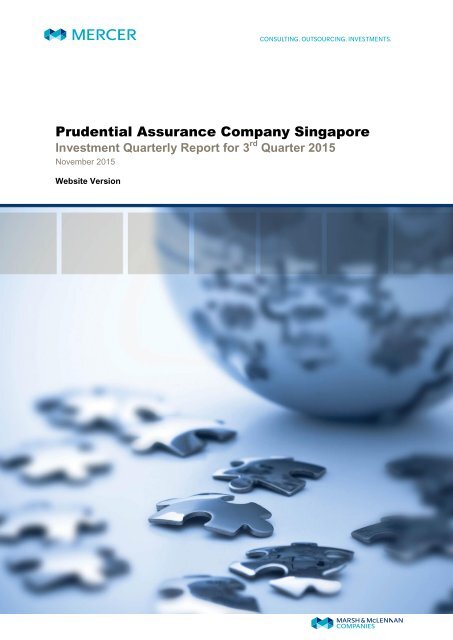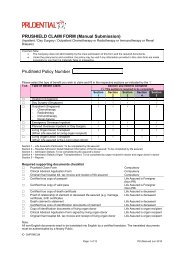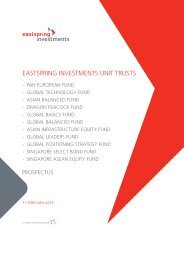Prudential Assurance Company Singapore
Investment Quarterly Report for 3 - Prudential Singapore
Investment Quarterly Report for 3 - Prudential Singapore
You also want an ePaper? Increase the reach of your titles
YUMPU automatically turns print PDFs into web optimized ePapers that Google loves.
<strong>Prudential</strong> <strong>Assurance</strong> <strong>Company</strong> <strong>Singapore</strong><br />
Investment Quarterly Report for 3 rd Quarter 2015<br />
November 2015<br />
Website Version
Content Page<br />
About Mercer ......................................................................................................................... 3<br />
Market Update ....................................................................................................................... 4<br />
Mercer Recommended Investment Strategy ......................................................................... 12<br />
Recommended Implemented Solution .................................................................................. 13<br />
Disclaimers ............................................................................................................................ 14
Mercer’s proposal for the Ministry of Finance – Accountant-General’s Department<br />
About Mercer<br />
Mercer Investments<br />
Mercer is a leading global provider of investment consulting services, and offers customised guidance at every stage<br />
of the investment decision, risk management and investment monitoring process. We have been dedicated to<br />
meeting the needs of clients for more than 35 years, and we work with the fiduciaries of pension funds, foundations,<br />
endowments and other investors in over 40 countries. We assist with every aspect of institutional investing (and retail<br />
portfolios in some geographies), from strategy, structure and implementation to ongoing portfolio management. We<br />
create value through our commitment to thought leadership; world-class, independent research; and top-notch<br />
consultants with local expertise.<br />
Mercer Investments has over 1,300 employees in 66 offices around the world.<br />
3
Mercer’s proposal for the Ministry of Finance – Accountant-General’s Department<br />
Market Update<br />
Asset Class<br />
Returns over<br />
last 3 months<br />
(%)<br />
Returns over<br />
last 12<br />
months (%)<br />
(As of 30 th Sept 2015)<br />
Ann. Returns<br />
over last 3<br />
years (%)<br />
Global Equity (MSCI World) -5.8 4.0 11.9<br />
Global Emerging Markets (MSCI Emerging Markets) -14.3 -9.9 -0.4<br />
Europe Equity (FTSE World Europe Index) -6.3 -1.6 7.9<br />
Asia ex. Japan Equity (MSCI Asia ex Japan) -15.1 -4.5 2.6<br />
<strong>Singapore</strong> Equity (STI) -19.0 -14.8 -3.0<br />
US Equity (S&P 500) -3.7 8.7 15.7<br />
Japan (Topix) -4.9 8.9 13.1<br />
China Equity (MSCI China) -17.0 3.4 6.0<br />
India Equity (MSCI India) -7.9 4.1 8.1<br />
Global Government Bond (Citi World Bond Index) 3.8 7.4 2.1<br />
<strong>Singapore</strong> Government Bond (UOB SG Govt Bond Index) 0.5 1.9 0.5<br />
Commodities (S&P GSCI) -6.1 -30.1 -14.4<br />
Data source: Bloomberg<br />
All returns are in SGD terms, in percentages, with dividends reinvested.<br />
The cut-off date for the prices is the last business day of the relevant quarter.<br />
Global Economic Comments<br />
There were few places for investors to hide in Q3, as a deterioration in risk appetite was accompanied by broadbased<br />
increases in correlations across the major asset classes. Although fears over Greece eventually subsided, the<br />
market narrative subsequently turned to the slowdown in China, the opacity of China’s policy responses, and the<br />
Fed’s apparent determination to proceed with lift-off. Along with the renewed decline in energy and other commodity<br />
prices, and growing doubts over forecasted US earnings growth, investors appeared to be re-assessing the<br />
sustainability of rich US earnings multiples and narrow credit spreads. We estimated that this re-assessment had<br />
culminated in a 60/40 portfolio of unhedged global equities and hedged global government bonds, giving US<br />
investors a return of -3.3% over the past year.<br />
Within risk markets, emerging market (“EM”) assets were the poorest performers in Q3. In local currency terms, the<br />
MSCI Emerging Markets index fell 12.0%, leading the index 8.0% lower over the year. In US Dollars, EM equities fell<br />
17.8% in the quarter, and 19.0% over the year. Emerging market debt (local currency) also returned -10.5% in the<br />
quarter, and -19.8% over the year, driven primarily by further weakness in exchange rates.<br />
Developed market (“DM”) equities also endured significant corrections. MSCI World fell by 7.6% in local currency<br />
terms, and by 8.3% in US Dollars.<br />
Fixed interest markets afforded little protection to investors. The benchmark 10-year government bond yields fell<br />
modestly in most major economies over the quarter, but the declines were largely isolated to sharp falls in inflation<br />
breakevens to post-crisis lows in many markets. In contrast, real yields in the US and in other developed economies<br />
drifted higher over the quarter, as the Fed continued to leave the door open to a September lift-off. Despite the return<br />
of risk-off sentiment, the net effect was a modest 1.8% return from global government bonds in the quarter, and a<br />
3.8% return over the year, in US Dollars. However, in other fixed interest markets, spreads widened in tandem with<br />
the weakness in equities markets, with investment grade credit subsequently returning just 0.3% and global high yield<br />
returning -3.6%, in US Dollars.<br />
The US Dollar major currency index jumped a further 4.6% over Q3, and had increased by 13.9% over the past year.<br />
However, the increase in Q3 was largely against higher yielding currencies, and the US Dollar had fallen modestly<br />
against both Euro and Yen. After some modest relief in Q2, energy and other commodity prices continued to fall in<br />
Q3. WTI crude oil prices plunged 24.2% in the quarter, briefly falling to below $US40/bbl in mid-August, while a wide<br />
4
Mercer’s proposal for the Ministry of Finance – Accountant-General’s Department<br />
range of other base metals prices also came under pressure. The S&P GSCI fell 19.3% in the quarter, and had fallen<br />
by 41.7% over the year, in US Dollars.<br />
Growth continued to diverge between the advanced and the emerging economies in 2015, holding up across most of<br />
the developed markets, but continuing to weaken in a range of emerging markets. Growth in China’s industrial<br />
economy slumped in Q2 to the lowest levels since the financial crisis, while the renewed declines in commodity<br />
prices and external funding problems pushed Brazil and Russia into even deeper recession. The slowdown in China,<br />
and fears of further Renminbi depreciation, also continued to ripple throughout Asia. Only India appeared to be<br />
largely insulated by way of a low US Dollar funding exposure, similar to that of eastern European economies.<br />
In contrast, GDP continued to grow at a moderate pace in the US, the Euro area and the UK, accompanied by further<br />
declines in unemployment. Japan’s cyclical upturn remained rather fragile and the country continued to struggle to<br />
overcome deflationary pressures. Slumping commodity export prices also hit growth in Canada, Australia and New<br />
Zealand. As with previous years, the second half again saw downward revisions to official and consensus forecasts,<br />
centered largely in the emerging world, but with some spillover into developed markets. The International Monetary<br />
Fund (IMF) revised down forecasted growth for 2015 and 2016 by 0.2% in both years, to 3.1% and 3.6% respectively.<br />
We view current risk-off sentiment partly as a market event, prompted by the end of quantitative easing in the US, the<br />
approach of interest rate normalization and the rise in the US Dollar. In our view, this shifting stance in US monetary<br />
policy and liquidity forced investors to re-assess the sustainability of spreads and equity valuations that had run<br />
ahead of increasingly challenged US corporate earnings fundamentals. In addition to the rise in the Dollar, excess<br />
global supply and the slowdown in China’s ‘old economy’ also contributed to the declines in commodity prices, and to<br />
pressures on USD-leveraged commodity producers. Inflation breakevens also continued to track energy and<br />
commodity prices lower.<br />
Against this backdrop, fears of a new ‘currency war’ and global recession, centered in China, appeared exaggerated,<br />
although we believe that the slowdown in EM has further to run, and that the risks to consensus DM forecasts<br />
remained tilted to the downside. In our view, changes to the Renminbi fixing arrangements should be viewed<br />
primarily as a further step in the liberalization of China’s financial markets and consistent with IMF demands. And<br />
while a greater role for market forces suggested the Renminbi might be biased to the downside, given the extent of<br />
domestic deleveraging and disinflation pressures, the authorities would be likely to continue intervening to avert more<br />
disorderly capital outflows. Rather, the new exchange rate peg appeared to have raised perceptions that the<br />
Renminbi would be a policy tool now, and that the direction of China’s currency would no longer be a one way bet.<br />
Indeed, the pattern of China’s overall growth in 2015 remained broadly consistent with policy objectives, and the<br />
pipeline of stimulus should ensure that the slowdown will remain manageable, notwithstanding rising concerns over<br />
co-ordination and implementation. Nevertheless, the slowdown will likely pose further challenges for EM, at a time<br />
when the strong US Dollar continues to suck away capital and curb the scope for more aggressive policy easing. The<br />
risks of contagion appeared lower than in previous episodes of EM capital flight, and growth in intra-regional trade<br />
accounted for much of the rising share of EM in global production, but in our view it would be imprudent to ignore the<br />
risk of further dampening on DM. Intensifying EM problems had already contributed to the tightening in global<br />
financial conditions, and (perhaps over-optimistically) consensus forecasts will continue to embody strong rebounds<br />
in EM growth in 2016.<br />
Chart 1 Chart 2<br />
In the United States, the strong Dollar was already compressing output, earnings and employment growth, and<br />
recent market volatility contributed to a further tightening in financial conditions. Net exports subtracted 0.6<br />
percentage points from GDP growth over the year to June 2015, after a broadly neutral contribution in each of the<br />
previous three years, with the weakness centered in the manufacturing sector. However, in the absence of further<br />
5
Mercer’s proposal for the Ministry of Finance – Accountant-General’s Department<br />
Dollar appreciation, this source of weakness should eventually ameliorate. In the meantime, moreover, private<br />
demand growth continued to broaden in the second half of 2015, and was expected to withstand the recent modest<br />
tightening in financial conditions. In addition to the continued strength in household income and balance sheet<br />
fundamentals, and the accompanying increases in consumer spending growth and residential construction activity,<br />
private fixed non-residential (business) investment continued to slowly recover.<br />
Business investments lagged the strong recoveries in corporate profits and margins throughout the current cycle, but<br />
remained close to cyclical highs in real terms during Q2. Although profit momentum slowed over the past year,<br />
growing skills shortages, pressure to maintain margins, and the prospect of rising interest rates were strong<br />
incentives for management to deploy more free cashflow into new capital expenditure. However, research and<br />
development (“R&D”) spending was at record highs as a proportion of GDP, while renewed capital deepening should<br />
also help eventually to revive US labour productivity growth. Ahead of this more ‘late cycle’ development, weak<br />
growth in output per worker and declining labour force participation suggested that the trend in US GDP growth may<br />
have sunk to below 2.0%, and below official Fed estimates. We remain cautious that consensus GDP growth<br />
forecasts, 2.5% in 2015 and 2.7% in 2016, underestimated these supply constraints.<br />
In the Euro area, immediate uncertainty around Greece subsided, which should allow moderate recovery,<br />
underpinned primarily by domestic demand, to continue through into 2016. In the core Eurozone area, German<br />
export growth appeared vulnerable to weakness in EM and the problems at Volkswagen, but domestic demand<br />
remained strong. Similarly, renewed stagnation in France was partly offset by relative strength in other parts of<br />
northern Europe. However, prospects remained brightest for the peripheral ‘program’ economies, where reforms and<br />
large gains in international competitiveness continued to spur strong cyclical upturns. Moreover, across the broader<br />
Euro area, bank lending standards continued to loosen through 2015, and which was reflected in a stirring in credit<br />
growth in the past quarter. Consensus forecasts proved resilient, and in our view forecast GDP growth of 1.7%, the<br />
expected strongest since 2011, appears achievable.<br />
Entering the second half of the year, growth also appeared to have moderated in the United Kingdom, with the<br />
weakening in manufacturing now spilling over into a range of service sectors. Despite improving growth in much of<br />
the Euro area, the UK manufacturing Purchasing Managers’ Index (“PMI”) slipped steadily through much of 2015,<br />
and largely reflected the rise in Sterling and an accompanying deterioration in international competitiveness.<br />
Consumption growth also appeared to have softened in Q3, which contributed to the UK services PMI slumping in<br />
September, to the lowest level since April 2013. Nevertheless, the slowdown in growth was expected to prove more<br />
of a ‘soft patch’ than a fundamental shift down, with the tight labour market and falling energy prices leading to a<br />
steady acceleration in real wage growth, and broadening house price gained a further support for household<br />
confidence. The consensus expects GDP growth of 2.5% in both 2015 and 2016, remained broadly unchanged in<br />
recent months.<br />
Chart 3 Chart 4<br />
In contrast to this picture of steady and moderate growth across the US and Europe, Japan’s cyclical upturn<br />
appeared to be faltering, as 2015 unfolded. The strong 1.1% advance in GDP in Q1 was followed by a 0.3%<br />
contraction in Q2, and followed by further falls in manufacturing production and sentiment, and a moderation in<br />
employment growth. The earlier decline in the unemployment rate appeared also to have stalled. After recovering<br />
strongly in the first half of 2015, exports and machinery goods orders softened, while indicators of consumer<br />
spending suggested continued weak growth. Correspondingly, the consensus forecast for growth in 2015 was<br />
revised down from 1.0% to 0.7% over the past quarter, although GDP was still anticipated to expand by a relatively<br />
healthy 1.5% in 2016.<br />
China was firmly at the centre of the current global growth scare. While the fallout from the collapse in China’s equity<br />
markets was likely to be limited, growth in the ‘old’ industrial economy appeared to have slowed much more sharply<br />
than expected, intensifying the downward pressure on commodity, producer and export prices. Indeed, there<br />
6
Mercer’s proposal for the Ministry of Finance – Accountant-General’s Department<br />
appeared to have been some recent softening in China’s labour market, which had defied the broader slowdown in<br />
GDP growth until now. In the meantime, the reputation of China’s policymakers also took a hit. Facing the formidable<br />
task of absorbing debt and capacity overhangs, while also rebalancing and liberalizing the economy, the handling of<br />
the stock market bubble and Renminbi peg had clearly confused investors. There were growing concerns that the<br />
anti-corruption drive was hampering implementation of the reform agenda, while there were fears also that the<br />
Renminbi would potentially be a policy tool now.<br />
Notwithstanding the apparent emergence of domestic political tensions, our base case for China remained broadly<br />
intact. Although introducing a greater role for market forces, we expect the authorities to resist depreciation of the<br />
Renminbi in the short-term. While the slowdown in the ‘old economy’ was partly structural, and will persist over the<br />
remainder of the decade, there was still scope for traditional monetary and fiscal policies to help manage the<br />
adjustment. Amid this downturn in investment and export growth, moreover, consumption spending and service<br />
sector growth remained broadly steady. Consumption accounted for 60% of growth in China’s GDP over the year to<br />
June 2015, up from 54% a year earlier.<br />
The structural shift down in China’s growth continued to reverberate through other emerging economies, contributing<br />
to a further intensification of capital outflows. In 2015, the risks of a broad-based contagion appeared lower than in<br />
previous episodes of capital flight, reflecting the diminished role of banking systems in intermediating capital flows,<br />
generally sounder sovereign balance sheets, with Brazil being a major exception, and a range of ‘winners’ from lower<br />
energy prices and economic reform, most notably India and eastern Europe. However, a number of others remained<br />
at risk of joining Brazil and Russia in recession, including the likes of Turkey and South Africa, with relatively large<br />
current account deficits, troublesome inflation, corporate sectors exposed to rising US Dollar liabilities, and limited<br />
commitment to painful economic rebalancing. While real exchange rates fell significantly across much of EM, growth<br />
in DM continued to be driven more by services sectors, dampening the potential recovery in EM exports. More<br />
positively, given the steep currency declines already, scope could emerge in 2016 for more aggressive policy easing,<br />
and which would provide a substantial fillip for broader recovery prospects.<br />
Chart 5 Chart 6<br />
Deepening downturns and Renminbi depreciation added to the global disinflationary impulse emanating from EM,<br />
exacerbated by the reluctance among many global commodities producers to shut in excess supply. Headline<br />
inflation appeared poised to fall back towards zero in most of the major developed economies, before rebounding as<br />
the earlier sharp fall in energy prices washed out, and which could still potentially temper the tentative moderate<br />
upturns in core inflation. This latest intensification of the major ‘transitory’ constraints on US inflation, and the recent<br />
return of financial market volatility, clearly stayed the Fed’s hand in September, and also increased uncertainty over<br />
the timing of lift-off in the UK. Perhaps, of greater surprise was the dovish commentary and guidance accompanying<br />
the Fed’s decision to leave the funds rate unchanged.<br />
The commencement of US interest rate normalization before the end of the year still remains a possibility. Some on<br />
the Federal Open Market Committee (“FOMC”) were clearly concerned over the extent to which the prolonged period<br />
of negative real borrowing rates may be encouraging excessive risk-taking and leverage. Moreover, there were good<br />
reasons to believe that the recent market volatility may reflect as much the Fed telegraphing its desire to lift interest<br />
rates, as to the slowdown in growth in China and EM. Indeed, the devaluation of the Renminbi coincided with the<br />
increasing disinflationary discomfort to China from the strengthening US Dollar. In the event where near-term data<br />
were to confirm that EM problems are unlikely to have a significant adverse impact on US GDP growth, it might not<br />
fully alleviate market volatility, but would remove one major hurdle for a 2015 lift-off. Against such a backdrop, we<br />
would expect Bank of England (“BoE”) to follow Fed early in 2016.<br />
7
Mercer’s proposal for the Ministry of Finance – Accountant-General’s Department<br />
Although deferral of lift-off suggested a potential risk of larger interest rate increases further down the track, we<br />
continue to expect a rather shallow tightening trajectory, somewhere between current market pricing and the<br />
September FOMC ‘dots’. A gradual profile seemed warranted in the face of lingering uncertainties over both the<br />
extent of labour market slack and the rate of potential US GDP growth, as well as the persistence of ‘transitory’<br />
factors tempering US inflation. Stubbornly weak US wage growth suggested that both Non-Accelerating Inflation Rate<br />
of Unemployment (“NAIRU”) and trend GDP growth may be lower than currently estimated by Fed, which would<br />
undermine the prospect of inflation returning to 2% over the next 2-3 years, while also suggesting a lower terminal<br />
funds rate.<br />
Moreover, there was at least an equal risk that the persistence of ‘transitory’ factors may actually reflect the depth of<br />
secular global disinflationary pressures. In such circumstances, a poorly calibrated pre-emptive tightening would<br />
amount to a policy mistake, and presumably amplifing those disinflationary pressures through further rises in the US<br />
Dollar and market volatility. Finally, circling back to the US labour market, in addition to the level of NAIRU, there was<br />
also considerable uncertainty over the short-run trade-off between unemployment and inflation expectations, i.e. the<br />
shape of the Phillips Curve. Despite evidence of a less flexible US labour market, wage growth and inflation<br />
expectations proved remarkably stable through the full cycle of a rising and falling unemployment rate, suggesting a<br />
flatter curve and looser relationship than in the past.<br />
In contrast to the US and the UK, both the European Central Bank (“ECB”) and Bank of Japan (“BoJ”) appeared open<br />
to the possibility of enlarging current asset purchase programs. Further balance sheet expansion could also help<br />
alleviate pressure on EM exchange rates as the Fed lifts rates, allowing more aggressive easing in EM monetary<br />
policy. In our view, deeper interest rate cuts would be required before taking a more constructive view on EM assets.<br />
8
Mercer’s proposal for the Ministry of Finance – Accountant-General’s Department<br />
Market Review<br />
(All returns are in Local Currency terms, unless otherwise stated)<br />
Pressure from the second quarter of 2015 showed little signs of abating in the third quarter, resulting in a broad selloff<br />
in risky assets. A growing sense of uncertainty prevalent among market participants was reflected in the spike in<br />
market volatility. In August 2015, intraday equity market volatility rose to levels that had not been seen since the<br />
global financial crisis.<br />
The sell-off off in risky assets was largely attributed to a surprise devaluation of the Chinese Yuan in August 2015.<br />
Against the backdrop of diverging monetary policies globally, the ongoing commodity price slump and the broad<br />
weakness in emerging markets assets, the latest shift in China’s foreign exchange policy sparked fears that China is<br />
increasingly prepared to export deep domestic disinflationary pressures abroad. This triggered an extension of the<br />
sell-off in risky assets that had begun at the end of June 2015. Commodity prices and emerging markets equities<br />
suffered the most in the face of slowing Chinese growth and a strong US Dollar.<br />
In the United States, the Federal Reserve Bank (“Fed”) chose to leave interest rates unchanged in its September<br />
meeting, citing concerns over recent global economic and financial weakness. While Consensus Economics still<br />
expected the world’s largest economy to grow at 2.4% this year, deflation remained a concern as the seasonally<br />
adjusted year-over-year change of US consumer prices declined to -0.1% in August largely due to the ongoing<br />
weakness in oil prices.<br />
In Europe, a provisional agreement for a third bailout was reached between Greece and its creditors in mid-July.<br />
Greece remained in the Eurozone and fears over risks of contagion were diminished. The Eurozone economy<br />
continued to improve tepidly, with seasonally adjusted GDP growth of 0.4% in the second quarter of 2015.<br />
Macroeconomic policies in Europe and in Japan remained very supportive, in contrast with the Fed and the Bank of<br />
England which had been slowly preparing for initial rate hikes.<br />
All major equity markets posted negative returns in the third quarter of 2015. Global equities saw a decline of 7.6%<br />
over the quarter. In Asia, the MSCI AC Asia ex-Japan Index, and in Japan, the Topix Index, yielded negative returns<br />
of 13.8% and 12.8% respectively. The poor performance of Japanese equities followed the release of mixed<br />
economic data which showed Japan falling into deflation in August 2015 for the first time since April 2013 in spite of<br />
the improving consumer spending and corporate earnings. Equities in the Emerging Markets also posted<br />
disappointing performance at -12.0%.<br />
9
Mercer’s proposal for the Ministry of Finance – Accountant-General’s Department<br />
Figure 1: Market indices 1 year ending 30 th Sep 2015 (in <strong>Singapore</strong> dollar terms, normalised to 100 at 3 Oct 2014)<br />
130<br />
120<br />
110<br />
100<br />
90<br />
MSCI World<br />
MSCI Asia ex Japan<br />
STI<br />
80<br />
S&P500<br />
Global Government Bonds<br />
<strong>Singapore</strong> Bonds<br />
70<br />
10/14 11/14 12/14 1/15 2/15 3/15 4/15 5/15 6/15 7/15 8/15 9/15<br />
Figure 2: 10-Year Government Bond Yield (in local currency)<br />
4.0<br />
Last Quarter<br />
Current<br />
3.0<br />
2.7<br />
2.5<br />
2.4<br />
2.0<br />
2.0<br />
1.0<br />
1.2<br />
1.1<br />
0.5<br />
0.4<br />
-<br />
<strong>Singapore</strong> US Japan Germany<br />
Bonds generally posted positive returns, with the exception of inflation-linked bonds and Asian bonds. Global bonds<br />
yielded a return of 1.9%, in local currency terms.<br />
10
WTI Cushing Crude Oil (US$/bbl)<br />
Gold (US$/oz)<br />
Mercer’s proposal for the Ministry of Finance – Accountant-General’s Department<br />
Figure 3: SGD against major currencies<br />
Spot Rates Current Last Q<br />
USD<br />
JPY<br />
2.0<br />
5.6<br />
7.9<br />
11.5<br />
SGD/USD 1.4225 1.3474<br />
SGD/100xJPY 1.1865 1.0999<br />
SGD/AUD 0.9981 1.0385<br />
SGD/EUR 1.5896 1.5018<br />
SGD/GBP 2.1520 2.1176<br />
-10.5<br />
-3.9<br />
AUD<br />
-1.3<br />
EUR<br />
5.8<br />
12-month return<br />
3-month return<br />
GBP<br />
1.6<br />
4.1<br />
-15 -10 -5 0 5 10 15<br />
The <strong>Singapore</strong> Dollar appreciated against the Australian Dollar by 3.9%. However, it depreciated against the<br />
Japanese Yen by 7.9%, the Euro by 5.8%, the US Dollar by 5.6%, and the Pound Sterling by 1.6%.<br />
Figure 4: Gold and Crude Oil Returns<br />
100<br />
1350<br />
90<br />
1300<br />
80<br />
1250<br />
70<br />
1200<br />
60<br />
1150<br />
50<br />
1100<br />
40<br />
1050<br />
30<br />
10/14<br />
11/14<br />
12/14<br />
1/15<br />
Gold (Spot)<br />
2/15<br />
3/15<br />
4/15<br />
WTI Crude Oil<br />
5/15<br />
6/15<br />
7/15<br />
7/15<br />
8/15<br />
1000<br />
9/15<br />
11
Mercer’s proposal for the Ministry of Finance – Accountant-General’s Department<br />
Mercer Recommended Investment Strategy<br />
4%<br />
5%<br />
6%<br />
10%<br />
75%<br />
Global Equity EM Equity <strong>Singapore</strong> Equity Global Bonds<br />
Lower Risk<br />
<strong>Singapore</strong> Bond 75%<br />
Global Bond 4%<br />
Global Equity 6%<br />
<strong>Singapore</strong> Equity 5%<br />
Asian Equity 10%<br />
Investors with this risk profile are mainly concerned with<br />
capital stability. They are prepared to accept only a minimal<br />
level of volatility. Overall returns are expected to be low<br />
relative to the other risk profiles.<br />
Investment Strategy expected volatility*: 4.9% p.a.<br />
Probability of loss over any 10-year period: 0.1%<br />
66% probability of generating returns of 4.4% p.a. or above**<br />
50% probability of generating returns of 4.8% p.a. or above**<br />
33% probability of generating returns of 5.3% p.a. or above**<br />
<strong>Singapore</strong> Bonds Corporate Bonds Asian Equity<br />
4%<br />
60%<br />
10%<br />
5%<br />
6%<br />
15%<br />
Global Equity EM Equity <strong>Singapore</strong> Equity Global Bonds<br />
Low to Medium Risk<br />
<strong>Singapore</strong> Bond 60%<br />
Global Bond 4%<br />
Global Equity 6%<br />
EM Equity 5%<br />
<strong>Singapore</strong> Equity 10%<br />
Asian Equity 15%<br />
Investors are chiefly concerned with achieving stable<br />
returns, particularly of capital returns. They are willing to<br />
accept a modest level of volatility to achieve these returns.<br />
Investment Strategy expected volatility*: 7.9% p.a.<br />
Probability of loss over any 10-year period: 0.9%<br />
66% probability of generating returns of 5.0% p.a. or above**<br />
50% probability of generating returns of 5.7% p.a. or above**<br />
33% probability of generating returns of 6.5% p.a. or above**<br />
<strong>Singapore</strong> Bonds Corporate Bonds Asian Equity<br />
4%<br />
20%<br />
Medium to High Risk<br />
<strong>Singapore</strong> Bond 45%<br />
Global Bond 4%<br />
Investors within this risk profile aim to achieve capital growth<br />
over the medium to long-term. They are prepared to accept<br />
higher volatility than Low to Medium risk profile to achieve<br />
this return.<br />
10%<br />
6%<br />
15%<br />
45%<br />
Global Equity 6%<br />
EM Equity 10%<br />
<strong>Singapore</strong> Equity 20%<br />
Asian Equity 15%<br />
Investment Strategy expected volatility*: 11.2% p.a.<br />
Probability of loss over any 10-year period: 2.8%<br />
66% probability of generating returns of 5.5% p.a. or above**<br />
50% probability of generating returns of 6.5% p.a. or above**<br />
33% probability of generating returns of 7.7% p.a. or above**<br />
Global Equity EM Equity <strong>Singapore</strong> Equity Global Bonds<br />
Higher Risk<br />
25%<br />
6% <strong>Singapore</strong> Bond 30%<br />
Global Bond 4%<br />
15% Global Equity<br />
EM Equity<br />
6%<br />
15%<br />
<strong>Singapore</strong> Equity<br />
30%<br />
20%<br />
Asian Equity 25%<br />
20%<br />
4%<br />
<strong>Singapore</strong> Bonds Corporate Bonds Asian Equity<br />
Investors with this risk profile seek high growth over the<br />
long-term. They are willing to accept a high level of volatility<br />
to achieve this so are not concerned about capital stability<br />
from year to year.<br />
Investment Strategy expected volatility*: 14.8% p.a.<br />
Probability of loss over any 10-year period: 5.4%<br />
66% probability of generating returns of 5.8% p.a. or above**<br />
50% probability of generating returns of 7.2% p.a. or above**<br />
33% probability of generating returns of 8.6% p.a. or above**<br />
Global Equity EM Equity <strong>Singapore</strong> Equity Global Bonds<br />
<strong>Singapore</strong> Bonds Corporate Bonds Asian Equity<br />
* The “Investment Strategy expected volatility” is, assuming a normal distribution, the standard deviation of the statistical distribution of returns, which are generated based on<br />
Mercer’s 20-year Capital Market Assumption (“CMAs”). Volatility refers to the amount of uncertainty or risk about the size of changes in an investment’s value. A higher volatility<br />
means that an investment’s value can potentially be spread out over a larger range of values.<br />
** Based on annualised returns over any 20-year period<br />
Mercer recommended investment strategy is a set of suggested allocations to asset classes that is generated using Mercer 20-year Capital Market Assumptions (“CMAs”). All<br />
risks and returns projections in this section are statistical in nature, using Mercer CMAs for the underlying asset classes allocated in this strategy, without considering any<br />
investment cost. Investors, implementing this strategy using appropriate Collective Investment Scheme (“CIS”) products as indicated below, are subjected to associated<br />
investment costs, and may or may not experience risks and returns as projected by Mercer here, which have been derived using Mercer’s CMAs. Actual return and risks<br />
experienced by investors is dependent on the combined performances of these allocated CISs.<br />
12
Mercer’s proposal for the Ministry of Finance – Accountant-General’s Department<br />
Recommended Implemented Solution<br />
5%<br />
10%<br />
10% Lower Risk<br />
PRUlink singapore dynamic bond fund 75%<br />
PRUlink singapore growth fund 5%<br />
PRUlink global managed fund 10%<br />
PRUlink asian equity fund 10%<br />
75%<br />
15% Low to Medium Risk<br />
PRUlink singapore dynamic bond fund 60%<br />
10%<br />
5%<br />
10%<br />
60%<br />
PRUlink singapore growth fund 10%<br />
PRUlink emerging markets fund 5%<br />
PRUlink global managed fund 10%<br />
PRUlink asian equity fund 15%<br />
15% Medium to High Risk<br />
10%<br />
10%<br />
45%<br />
PRUlink singapore dynamic bond fund 45%<br />
PRUlink singapore growth fund 20%<br />
PRUlink emerging markets fund 10%<br />
PRUlink global managed fund 10%<br />
PRUlink asian equity fund 15%<br />
20%<br />
25% Higher Risk<br />
30%<br />
PRUlink singapore dynamic bond fund 30%<br />
PRUlink singapore growth fund 20%<br />
PRUlink emerging markets fund 15%<br />
10%<br />
PRUlink global managed fund 10%<br />
PRUlink asian equity fund 25%<br />
15%<br />
20%<br />
Performance of Implemented Solution<br />
Model Portfolio<br />
Lower Risk<br />
Low to Medium Risk<br />
Medium to High Risk<br />
Higher Risk<br />
Last 3 months<br />
Returns (%)<br />
-2.0<br />
-4.0<br />
-5.9<br />
-7.9<br />
Last 6 months<br />
Returns (%)<br />
-3.3<br />
-5.6<br />
-8.1<br />
-10.7<br />
Last 12 months Since Inception<br />
Returns (%) Returns (% p.a.)<br />
1.6<br />
2.5<br />
-0.9<br />
2.0<br />
-2.3<br />
1.7<br />
-5.3 1.0<br />
13
Mercer’s proposal for the Ministry of Finance – Accountant-General’s Department<br />
Disclaimers<br />
Important notices<br />
© 2015 Mercer LLC. All rights reserved.<br />
This contains confidential and proprietary information of Mercer and is intended for the exclusive use of the parties to<br />
whom it was provided by Mercer. Its content may not be modified, sold or otherwise provided, in whole or in part, to<br />
any other person or entity, without Mercer’s written permission.<br />
The findings, ratings and/or opinions expressed herein are the intellectual property of Mercer and are subject to<br />
change without notice. They are not intended to convey any guarantees as to the future performance of the<br />
investment products, asset classes or capital markets discussed. Past performance does not guarantee future<br />
results.<br />
This does not contain investment advice relating to your particular circumstances. No investment decision should be<br />
made based on this information without first obtaining appropriate professional advice and considering your<br />
circumstances.<br />
Information contained herein has been obtained from a range of third party sources. While the information is believed<br />
to be reliable, Mercer has not sought to verify it. As such, Mercer makes no representations or warranties as to the<br />
accuracy of the information presented and takes no responsibility or liability (including for indirect, consequential or<br />
incidental damages), for any error, omission or inaccuracy in the data supplied by any third party.<br />
This does not constitute an offer or a solicitation of an offer to buy or sell securities, commodities and/or any other<br />
financial instruments or products.<br />
Mercer's investment consulting business rates and/or recommends strategies of investment managers, some of<br />
whom are either Mercer clients, Mercer affiliates or clients of Mercer’s affiliates. The services provided to those<br />
managers may include a broad range of consulting services as well as the sale of licenses to use Mercer’s<br />
proprietary software and databases and/or subscriptions to Mercer's investment forums. Policies are in place to<br />
address these and any other conflicts of interest that may arise in the course of Mercer’s business. This is only a<br />
summary of Mercer’s conflicts of interest. For more information on Mercer’s conflict of interest policies, contact your<br />
representative.<br />
Mercer manager universes are constructed using data and information provided to Mercer either directly or via third<br />
party providers. The universes are intended to provide collective samples of strategies that best allow for robust peer<br />
group comparisons to be conducted over a chosen timeframe. Mercer does not assert that the peer groups are<br />
wholly representative of and applicable to all strategies available to individual investors. Universe distributions are<br />
calculated based on the data that was in the Manager’s database at the time that the universe was constructed, and<br />
may therefore change over time due to additional information supplied by an investment manager or revisions to<br />
data.<br />
The value of your investments can go down as well as up, and you may not get back the amount you have invested.<br />
Investments denominated in a foreign currency will fluctuate with the value of the currency. Certain investments carry<br />
additional risks that should be considered before choosing an investment manager or making an investment decision.<br />
The model portfolios provided herein are investment strategies designed and constructed by Mercer for reference<br />
and general information only with respect to the allocation rates to each fund in order to replicate an investment<br />
strategy that matches certain risk category and appetite of Investors. They are not investment products nor constitute<br />
a collective investment scheme as defined under the Financial Advisers Act or any other relevant regulations in<br />
<strong>Singapore</strong>. The Portfolio Solutions and any relevant investment products are offered, distributed and marketed solely<br />
by <strong>Prudential</strong>, and Mercer is not in any way offering any financial advice to you in relation thereto.<br />
14
Mercer (<strong>Singapore</strong>) Pte Ltd<br />
8 Marina View #09-08<br />
Asia Square Tower 1<br />
<strong>Singapore</strong> 018960
















